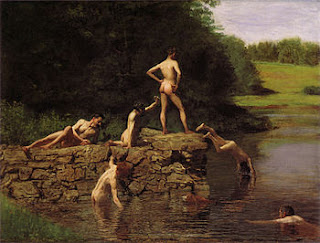(detail of a panel painting c. 1480–90)
Civic Museum, Padua, Italy
I.
As everybody knows, the Ἀργοναῦται were the heroic crew aboard the good ship Argo who, sometime before the Trojan War kicked off, accompanied Jason on his quest to find the Golden Fleece, protected by the goddess Hera.
Whether there is any historical basis to this ancient Greek myth - or whether it was pure fiction - is debatable, but hardly important. It remains, factual or not, central within the Western cultural imagination and, in the modern world, the term argonaut refers to anyone engaged in any kind of quest of discovery ...
II.
For Nietzsche, a philosophical argonaut was one who continually sought out what he terms die große Gesundheit - that is to say, a form of well-being way beyond the bourgeois model of good health we've been given and endlessly told we have to protect; a form of well-being that doesn't make us superhuman, but, on the contrary, allows us to conceive of that which lies overman.
In The Gay Science, Nietzsche describes this new and greater type of health as "more seasoned, tougher, more audacious, and gayer than any previous health" [1] and he argues that anyone who wishes like an artist-philosopher to experience every desire and sail round the dangerous coastal regions of the soul, needs this great health above all else.
Argonauts of the spirit, who stand divinely apart from others and who "with more daring than is prudent" risk disastrous shipwrecks, will eventually come upon "an as yet undiscovered country whose boundaries nobody has surveyed [...] a world so overrich in what is beautiful, strange, questionable, terrible, and divine" that to return home no longer holds the slightest attraction.
III.
In 2015, the genre-defying American writer Maggie Nelson published her award-winning and best-selling book The Argonauts; a series of autotheoretical reflections on desire, identity, family, etc.
For Nelson, the term refers to one who sets out to explore (in a quasi-Barthesian manner [2]) the possibilities (and limitations) of love and language and she discusses in detail her relationship with the transgender artist Harry Dodge, with whom she lives in Los Angeles.
This queering of the term Argonaut is certainly an interesting development and one wonders what Apollonius would have made of it ...?
Of course, as almost nothing is known about this ancient Greek author who composed the epic poem about Jason and his quest to locate the Golden Fleece in the 3rd century BC - the Argonautika - it's impossible to answer this question.
However, as Apollonius was clearly interested in the pathology of love, I'm fairly confident he'd approve of Nelson's "always questioning, sometimes wonderfully lyrical" [3] attempt to document the series of bodily experiments she and Harry engage in in order to construct a happy and rewarding life [4]. He might even recognise Nelson's book as belonging to a classical genre of literature that deals with queer phenomena: paradoxography.
The literary critic and cultural historian Lara Feigel rightly identifies the question that haunts Nelson's book; namely, can a love that claims to be radically-other or queer unfold within a conventional domestic setting? Or, to put it another way: can one be a sexually and socially transgressive Argonaut and also a regular mom?
Although she attempts to get round this by insisting that "queerness can hold together forms of strangeness that have nothing to do with sexual orientation" [5], Nelson remains "conscious of the dangers of 'homonormativity' [...] and aware that the more the state opens its institutions to the LGBTQ world, the less that world will "'be able to represent or deliver on subversion, the subcultural, the underground, the fringe'" [6].
Perhaps that's the ultimate sign of the Argonaut: someone who wants the best of both worlds; someone who thinks it reasonable to demand the impossible ...
Notes
[1] Nietzsche, Die Fröliche Wissenschaft (1887), V. 382. I am using the English translation by Walter Kaufmann published as The Gay Science (Vintage Books, 1974). See pp. 346-347. Lines quoted here are on p. 346.
[2] According to Nelson, the title is a reference to Barthes's idea that two people in a long-term love affair have to continually renew things without changing the form of their relationship - i.e., a bit like the Argonauts had to gradually replace each piece of their ship. Nelson expresses her surprise and joy at the manner in which love can be forever renewed.
See the sections Le vaisseau Argo and Le travail du mot in Roland Barthes, trans. Richard Howard (Papermac, 1995), pp. 46 and 114.
[3] Lara Feigel ...'The Argonauts by Maggie Nelson review - a radical approach to genre and gender' The Guardian (27 March 2016): click here.
[4] Whilst Maggie busies herself becoming pregnant with a sperm donor, Harry undergoes a bilateral mastectomy and begins taking testosterone.
[5-6] Lara Feigel ... op. cit.
Fot a follow up post to this one - on board the Ship of Theseus with Melissa Mesku - click here.
I am grateful to Maria Karouso whose blog post on the Greek poet Seferis and mythic history inspired this one: click here.





